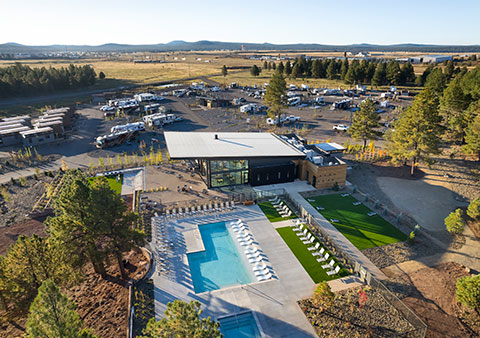Report on Camp VC: A Model for Community-Led Sustainable Development
1.0 Introduction and Organizational Background
This report analyzes the Camp VC initiative, a community-focused organization founded by Gemma Harrison in 2016. Originating from informal motorcycle lessons in a London car park, Camp VC has evolved into a large-scale annual festival in North Wales. The organization has cultivated a network of over 30,000 women and non-binary individuals. Its core mission is to provide a safe, inclusive, and non-judgmental environment for participants to learn new skills, primarily in action sports, thereby fostering personal transformation and community connection. This analysis will focus on the initiative’s significant contributions to several United Nations Sustainable Development Goals (SDGs).
2.0 Alignment with Sustainable Development Goals (SDGs)
Camp VC’s operational model and outcomes demonstrate a strong, practical alignment with multiple SDGs, particularly those concerning gender equality, health, education, and partnerships.
2.1 SDG 5: Gender Equality
Camp VC directly addresses SDG 5 by creating dedicated spaces for women and non-binary people to thrive in traditionally male-dominated fields.
- Empowerment and Skill Development: The initiative has successfully trained over 3,200 women to ride motorcycles and over 800 to skateboard, providing tangible skills and building confidence.
- Challenging Gender Norms: By centering women and non-binary individuals in action sports, Camp VC actively dismantles gender stereotypes and creates new, inclusive models of participation.
- Safe and Inclusive Spaces: The core principle of the event is to offer a non-judgmental environment, which is critical for fostering the full and effective participation of women in all aspects of community life.
2.2 SDG 3: Good Health and Well-being
The initiative promotes both physical and mental well-being, contributing directly to the targets of SDG 3.
- Physical Activity: The festival encourages participation in a wide range of physical activities, including motorcycling, skateboarding, archery, and strength training.
- Mental Well-being: A key reported outcome is the unique combination of freedom and safety felt by participants. This supportive atmosphere reduces anxiety and fosters a sense of belonging and self-worth, with one participant noting, “I’ve never felt so free and so safe at the same time.”
- Community Support: The strong community foundation acts as a support system, which is a crucial component of mental and emotional health. Harrison notes, “People come to be topped up by this event.”
2.3 SDG 4: Quality Education
Camp VC provides a unique model of informal, lifelong learning that aligns with the principles of SDG 4.
- Accessible Learning: The event removes barriers to entry for complex skills, welcoming absolute beginners and fostering a peer-to-peer learning environment.
- Organic Mentorship: The structure intentionally blurs the lines between instructor and learner, allowing for mentorship to flow organically between beginners, experienced participants, and professional athletes.
- Inclusive Education: The approach of “come and learn with us” creates an inclusive educational environment free of the ego or competition often found in traditional learning settings.
2.4 SDG 10: Reduced Inequalities
By specifically targeting and creating opportunities for women and non-binary people, Camp VC works to reduce inequalities in access to recreational and community activities.
- Fostering Inclusion: The event provides a platform for individuals who may feel excluded from mainstream sporting cultures.
- Empowering Marginalized Voices: It creates a world where participants can define their own identities and experiences without needing to “fit into a box,” thereby promoting social inclusion.
2.5 SDG 17: Partnerships for the Goals
The success and sustainability of Camp VC are reinforced by strategic collaborations, embodying the spirit of SDG 17.
- Corporate Collaboration: Long-term partnerships with over 130 brands, including Red Bull, YETI, and Royal Enfield, provide essential financial support, resources, and cultural credibility.
- Shared Values: Partners are selected based on alignment with the event’s values. YETI’s focus on sustainability and Royal Enfield’s initiatives to empower female racers are prime examples of mutually beneficial partnerships that advance shared goals.
- Community Amplification: These collaborations extend the reach and impact of the initiative, allowing it to touch more lives and strengthen its model for sustainable community building.
3.0 Key Impacts and Future Outlook
3.1 Measured Impact
The effectiveness of the Camp VC model is demonstrated by key performance indicators:
- Participation and Engagement: In 2024, 78% of attendees tried a new activity for the first time.
- Participant Retention: A 93% return rate indicates high levels of satisfaction and community loyalty.
- Community Growth: The network has expanded from a small group to over 30,000 individuals.
3.2 Future Strategy
The founder’s vision is to scale the initiative’s impact globally without compromising its core values of authenticity and community. The goal is to expand access to this transformative experience while ensuring the soul of the community remains intact. This strategy ensures the long-term sustainability of its contributions to the SDGs.
1. Which SDGs are addressed or connected to the issues highlighted in the article?
The article on Camp VC highlights issues and initiatives that are directly connected to several Sustainable Development Goals (SDGs). The primary focus is on empowerment, community building, and well-being, which aligns with the following goals:
-
SDG 3: Good Health and Well-being
The article emphasizes the transformational and joyful experience of Camp VC, which contributes to the mental and emotional well-being of its participants. It describes the event as a place where people “come to be topped up” and feel “completely seen.” The creation of a safe space to overcome fears, as exemplified by the woman who learned to ride after an injury, directly promotes mental health.
-
SDG 5: Gender Equality
This is a central theme of the article. Camp VC was founded to create a dedicated space for women and non-binary people to learn skills like motorcycling and skateboarding, which are often male-dominated. The article explicitly frames this as “Building a New Feminism—One Ramp at a Time,” focusing on creating new, inclusive systems rather than just fighting for space in existing ones. It is an initiative designed to empower women and non-binary individuals by providing them with skills, confidence, and a supportive community.
-
SDG 10: Reduced Inequalities
By specifically creating an inclusive community for “women and non-binary people,” Camp VC works to reduce inequalities. It provides a platform for a specific demographic to participate fully in activities from which they might otherwise feel excluded. The ethos of the camp, where “beginners learn not just from instructors, but from each other,” and where there is no ego or competition, promotes social inclusion irrespective of skill level or background.
-
SDG 17: Partnerships for the Goals
The article clearly details how Camp VC has leveraged partnerships to achieve its mission. It mentions collaborations with “over 130 brand and grassroots community partners,” including major brands like Red Bull, YETI, and Royal Enfield. These partnerships provide financial support, cultural credibility, and marketing amplification, demonstrating a successful model of civil society and private sector collaboration to achieve social goals.
2. What specific targets under those SDGs can be identified based on the article’s content?
Based on the activities and outcomes described in the article, several specific SDG targets can be identified:
-
Under SDG 3: Good Health and Well-being
- Target 3.4: “By 2030, reduce by one third premature mortality from non-communicable diseases through prevention and treatment and promote mental health and well-being.” The article’s focus on creating a “non-judgmental environment” where participants feel “so free and so safe at the same time” directly contributes to the promotion of mental health and well-being. The community and sense of belonging described are key protective factors for mental health.
-
Under SDG 5: Gender Equality
- Target 5.1: “End all forms of discrimination against all women and girls everywhere.” Camp VC creates a space free from the judgment and potential discrimination that women and non-binary people may face in male-dominated sports, thereby countering discriminatory social norms.
- Target 5.5: “Ensure women’s full and effective participation and equal opportunities for leadership in political, economic and public life.” While not focused on political or economic life, the event ensures women’s “full and effective participation” in recreational and community life. It empowers them with new skills and confidence. The founder, Gemma Harrison, also serves as a model of female leadership.
-
Under SDG 10: Reduced Inequalities
- Target 10.2: “By 2030, empower and promote the social, economic and political inclusion of all, irrespective of age, sex, disability, race, ethnicity, origin, religion or economic or other status.” The article highlights the social inclusion and empowerment of women and non-binary people. It creates a community that is intentionally inclusive, where “Olympic athletes and absolute beginners share ramps and campfires.”
-
Under SDG 17: Partnerships for the Goals
- Target 17.17: “Encourage and promote effective public, public-private and civil society partnerships, building on the experience and resourcing strategies of partnerships.” The article provides a clear example of this target in action, detailing how partnerships with Red Bull, YETI, and Royal Enfield have been crucial for the growth, credibility, and reach of Camp VC.
3. Are there any indicators mentioned or implied in the article that can be used to measure progress towards the identified targets?
Yes, the article contains both quantitative and qualitative data that can serve as indicators for measuring progress towards the identified targets.
-
Indicators for SDG 3 (Target 3.4)
- Qualitative Indicator (Sense of Well-being): The quote from a participant stating, “I’ve never felt so free and so safe at the same time,” serves as a powerful testimonial to the event’s impact on mental well-being.
- Quantitative Indicator (Participant Engagement and Satisfaction): The statistics “In 2024, 78% of attendees tried something new for the first time, and 93% said they would return” indicate high levels of engagement, satisfaction, and a positive environment conducive to well-being.
-
Indicators for SDG 5 (Target 5.5)
- Quantitative Indicator (Participation and Skill Acquisition): The article provides specific numbers: “over 3,200 women have learned to ride motorcycles and more than 800 have taken up skateboarding.” This directly measures the participation of women in these activities.
- Quantitative Indicator (Community Growth): The growth of the network to “over 30,000 women and non-binary people” indicates the scale and reach of the empowerment initiative.
-
Indicators for SDG 10 (Target 10.2)
- Qualitative Indicator (Inclusive Environment): The description of the environment as “free of ego or competition” and a place where the “boundaries between teacher and learner are intentionally blurred” serves as an indicator of a successfully inclusive social space.
-
Indicators for SDG 17 (Target 17.17)
- Quantitative Indicator (Number of Partnerships): The article states that Camp VC has “over 130 brand and grassroots community partners.”
- Qualitative Indicator (Nature of Partnerships): The descriptions of the collaborations with Red Bull (“athlete network and marketing amplification”), YETI (“sponsor the skate ramp”), and Royal Enfield (“transforming what motorcycle culture can look like”) provide evidence of the effectiveness and strategic nature of these partnerships.
4. Table of SDGs, Targets, and Indicators
| SDGs | Targets | Indicators |
|---|---|---|
| SDG 3: Good Health and Well-being | 3.4: Promote mental health and well-being. |
|
| SDG 5: Gender Equality | 5.5: Ensure women’s full and effective participation and equal opportunities. |
|
| SDG 10: Reduced Inequalities | 10.2: Empower and promote the social inclusion of all. |
|
| SDG 17: Partnerships for the Goals | 17.17: Encourage and promote effective public-private and civil society partnerships. |
|
Source: forbes.com







